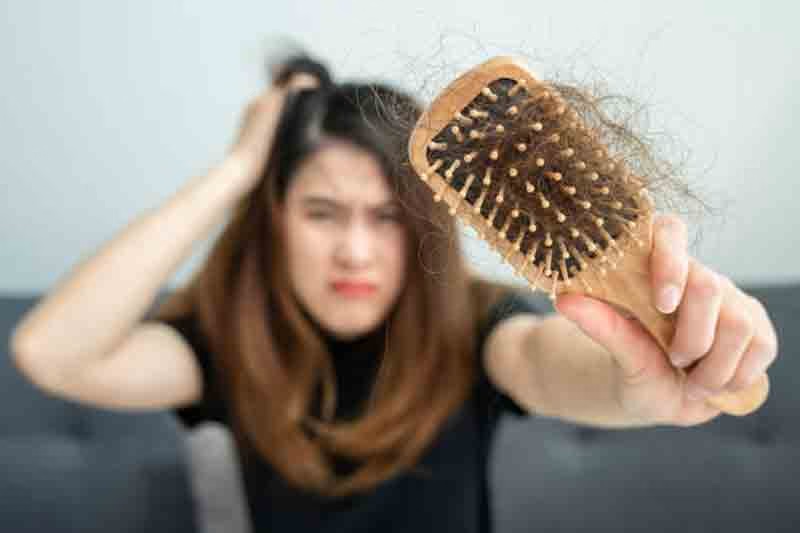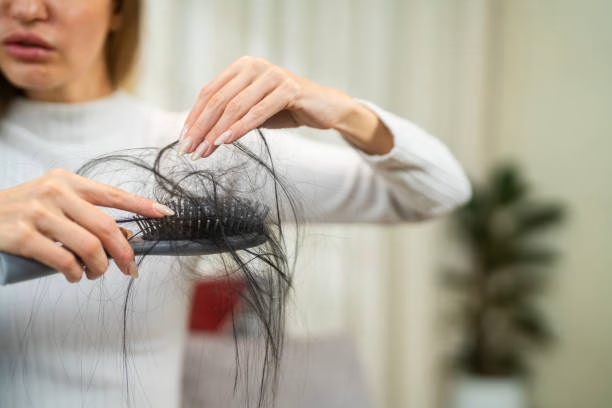Introduction
Hair has always been more than just strands of protein. It represents health, identity, and confidence. But in recent years, doctors, dermatologists, and researchers worldwide are raising concerns about a troubling trend hair loss among young adults is rising at an alarming rate. Once considered a problem of aging, thinning hair and receding hairlines are now affecting people in their early 20s and even late teens.

What’s driving this surge? Experts point to a toxic mix of stress, poor diet, sedentary lifestyle, and environmental factors. Combined with genetic predispositions, these lifestyle choices are accelerating hair fall, leaving millions searching for solutions.
This editorial feature explores the causes, science, consequences, and potential remedies for hair loss among young adults.
The Growing Epidemic of Hair Loss in Young Adults
According to a 2024 study by the International Journal of Trichology, over 25% of men experience visible hair loss before the age of 21, while one in three women under 30 report excessive hair shedding. The numbers have doubled in the last decade, reflecting a shift in health patterns.
Social media is also amplifying awareness. Platforms like Instagram, TikTok, and YouTube are filled with content creators discussing “premature balding,” DIY hair care, and expensive hair transplants. Clinics in India, Turkey, South Korea, and the U.S. report a surge in demand for hair restoration surgeries among people aged 20–35.
Clearly, hair loss among young adults is no longer a niche issue. It’s becoming a widespread health and social concern.
Stress: The Silent Enemy of Hair
Psychological Stress and Hair Follicles
Stress is one of the most common yet underestimated causes of hair loss. The human body responds to stress by releasing cortisol, a hormone that disrupts the natural hair growth cycle.
- Telogen Effluvium: Stress pushes hair follicles into the “resting” phase, causing sudden, diffuse shedding.
- Trichotillomania: Some individuals cope with stress by compulsively pulling out their hair.
- Alopecia Areata: In extreme cases, stress may trigger autoimmune conditions where the immune system attacks hair follicles.
A 2022 Harvard Medical School study confirmed that chronic stress accelerates hair follicle aging, reducing their ability to regenerate. This explains why many young adults facing academic pressure, career uncertainty, or relationship struggles report hair loss.
Poor Diet: Fueling the Problem from Within
Hair is primarily made of keratin, a protein that depends on adequate nutrition. Yet, modern eating habits often lack the nutrients essential for healthy hair.
Nutritional Deficiencies Causing Hair Loss
- Protein Deficiency – Leads to weaker hair strands.
- Iron Deficiency (Anemia) – Causes reduced oxygen supply to follicles.
- Vitamin D Deficiency – Weakens hair roots and slows regrowth.
- B Vitamins (Biotin, B12, Niacin) – Critical for keratin production.
- Omega-3 Fatty Acids – Maintain scalp hydration and prevent dryness.
The Junk Food Connection
Young adults increasingly consume fast food, sugary beverages, and processed snacks high in trans fats and refined carbs. These foods increase inflammation in the body, disrupt hormones, and lead to excess oil production on the scalp worsening hair fall.
Nutritionists emphasize a balanced diet rich in leafy greens, nuts, eggs, fish, and whole grains as essential for reversing early hair thinning.
The Role of Technology and Lifestyle Habits
Today’s digital lifestyle contributes in unexpected ways to hair loss among young adults.
- Screen Time & Sleep Disruption: Excessive late-night scrolling on smartphones and laptops disrupts melatonin production, affecting hair growth.
- Sedentary Lifestyle: Lack of exercise reduces blood circulation to the scalp.
- Excessive Heat Styling: Frequent use of hair straighteners, curlers, and dryers weakens hair shafts.
- Harsh Chemical Treatments: Bleaching, coloring, and keratin treatments damage follicles over time.
Dermatologists warn that habitual neglect combined with cosmetic damage can accelerate baldness even in those without strong genetic predisposition.
Genetics: An Inescapable Factor for hair loss among young adults
While lifestyle plays a massive role, genetics cannot be ignored. Androgenetic Alopecia (pattern baldness) remains the most common form of hair loss, inherited from family history. However, what’s alarming is how lifestyle accelerates genetic tendencies.
Doctors note that many young men genetically predisposed to baldness are losing hair 5–10 years earlier than their fathers or grandfathers due to stress and diet. Similarly, women with a family history of thinning hair are experiencing earlier onset post-college.
The Psychological Impact of Hair Loss
For young adults, hair loss isn’t just a cosmetic concern it’s a mental health issue. Studies show:
- Social Anxiety: Young people with visible hair thinning avoid parties, dating, and social gatherings.
- Depression: Balding often triggers feelings of inadequacy and low self-worth.
- Body Dysmorphic Disorder (BDD): Some develop an obsession with their appearance, spending hours checking mirrors or seeking treatments.
The beauty-driven culture of Instagram and TikTok amplifies these insecurities, where full hair is seen as a symbol of youth, vitality, and attractiveness.
Treatment Options: From Natural to High-Tech
1. Lifestyle & Home Remedies
- A balanced diet rich in protein and iron.
- Stress management through yoga, meditation, and therapy.
- Regular scalp massages with coconut, castor, or rosemary oil.
2. Medical Treatments
- Minoxidil: Over-the-counter topical solution proven to slow hair loss.
- Finasteride: Prescription pill for male pattern baldness.
- Platelet-Rich Plasma (PRP) Therapy: Uses the patient’s blood plasma to stimulate hair growth.
- Laser Therapy: Low-level light therapy devices to strengthen follicles.
3. Surgical Solutions
- Hair Transplants: Advanced techniques like FUE (Follicular Unit Extraction) are increasingly popular among 20–30-year-olds.
- Scalp Micropigmentation: A non-surgical tattooing solution to mimic hair density.
4. Emerging Innovations
Biotech companies are experimenting with stem cells and CRISPR-based gene editing to regenerate hair follicles. If successful, these could revolutionize hair restoration by 2030.
The Business of Hair Loss
The rising demand for solutions has created a booming global industry.
- The global hair restoration market was valued at $6.1 billion in 2023.
- It is projected to reach $12.9 billion by 2031, with Asia-Pacific leading growth.
- India and Turkey have become global hubs for affordable, high-quality hair transplants, attracting medical tourists from Europe and the Middle East.
Cosmetic brands are also launching anti-hairfall shampoos, serums, and supplements, often endorsed by influencers and celebrities.
Prevention: The Best Cure
Experts emphasize that early intervention is the key. Hair loss caught in its initial stages can often be reversed. Preventive steps include:
- Regular Health Checkups: Screen for deficiencies and hormonal imbalances.
- Balanced Diet: Include protein, vitamins, and omega-3 fatty acids.
- Stress Management: Adopt mindfulness, hobbies, or physical exercise.
- Gentle Hair Care: Avoid over-washing and harsh chemicals.
- Adequate Sleep: Ensure 7–8 hours of uninterrupted rest.
Expert Voices
Dr. Anjali Verma, a dermatologist in New Delhi, notes:
“We are seeing 22-year-olds with bald spots, something that was rare a decade ago. Stress and diet are the two biggest culprits. Awareness and early treatment can save them from permanent damage.”
Nutritionist Marco Rossi in Milan adds:
“What you eat directly reflects in your hair. A poor diet not only causes hair loss but also affects skin, nails, and overall vitality. The key lies in balanced nutrition.”
The Road Ahead
Hair loss among young adults is a wake-up call about the impact of modern lifestyle on health. Just as rising cases of obesity and diabetes reveal poor dietary patterns, premature baldness reflects how stress and poor nutrition are reshaping human biology.
As medicine advances, treatments will become more effective and accessible. But prevention through stress control, healthier diets, and mindful living remains the strongest shield.

Conclusion: Hair loss among young adults
Hair loss among young adults is no longer a vanity issue. It’s a health and societal concern, with implications for mental well-being, self-confidence, and even professional opportunities in a beauty-driven world.
The rise in cases is a reminder: the choices we make in food, stress management, and lifestyle today shape not just our health but even how we look tomorrow. By acting early, young adults can protect their hair and their confidence for the future.



